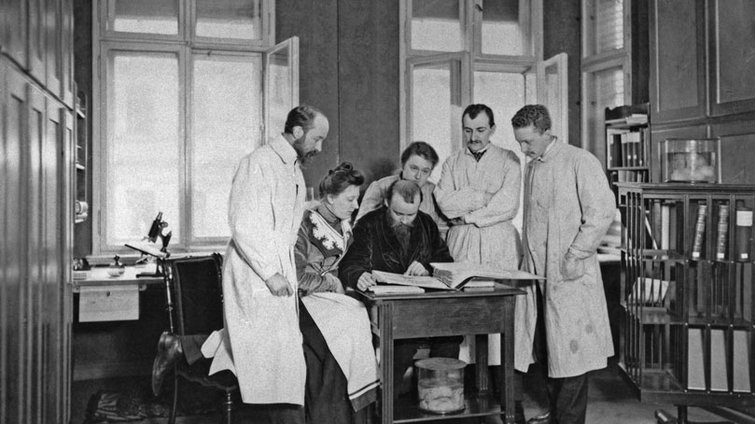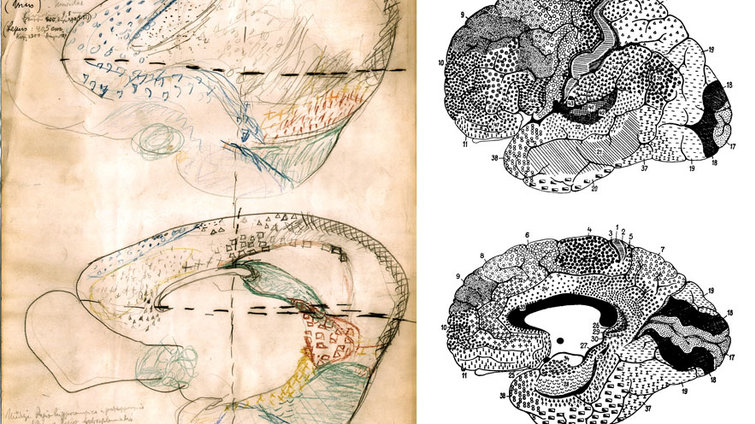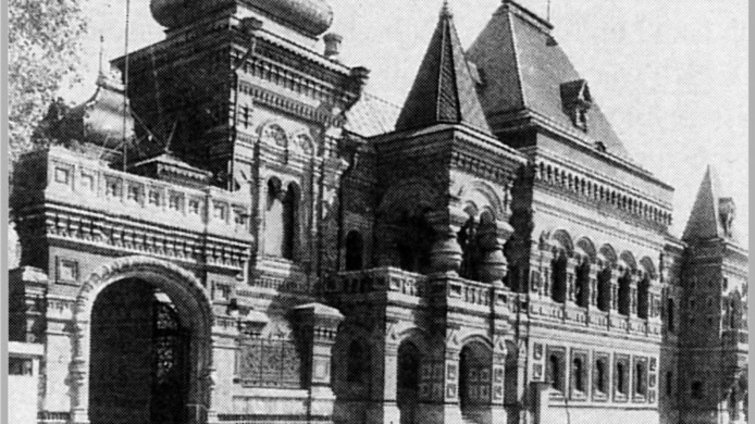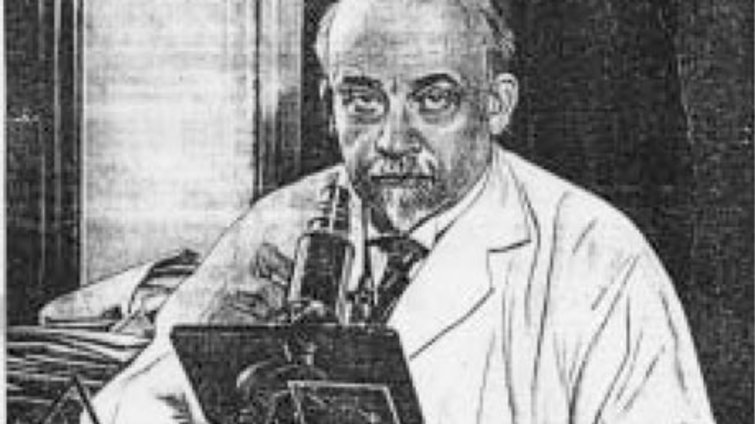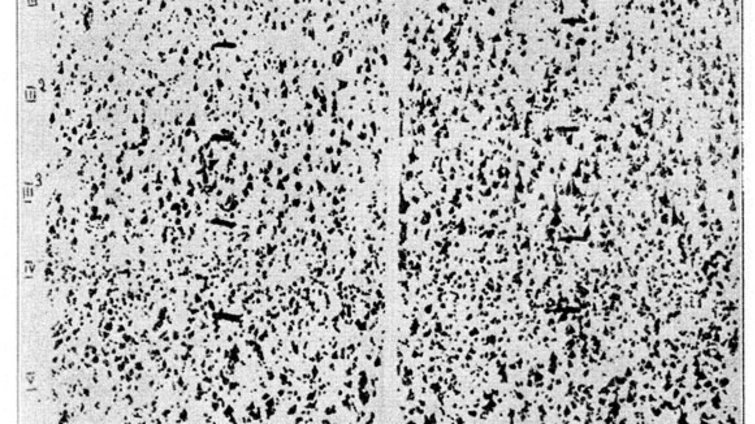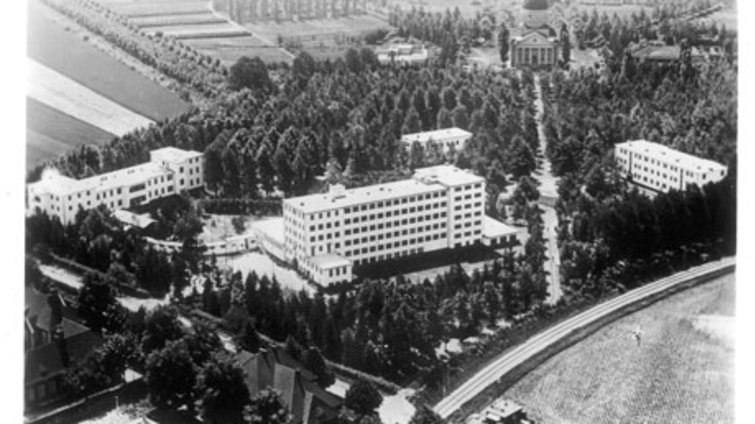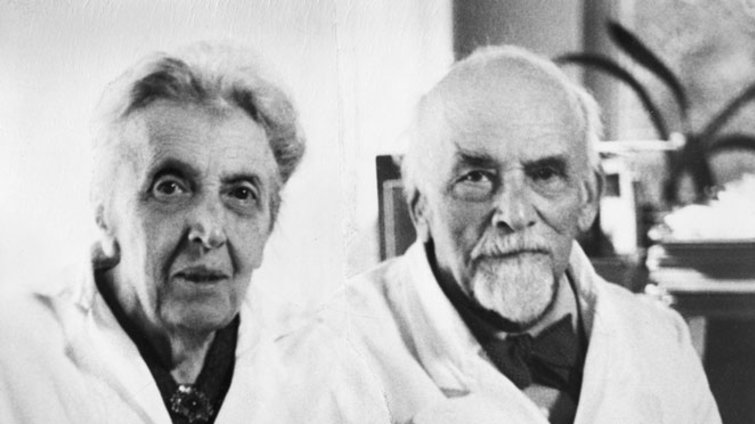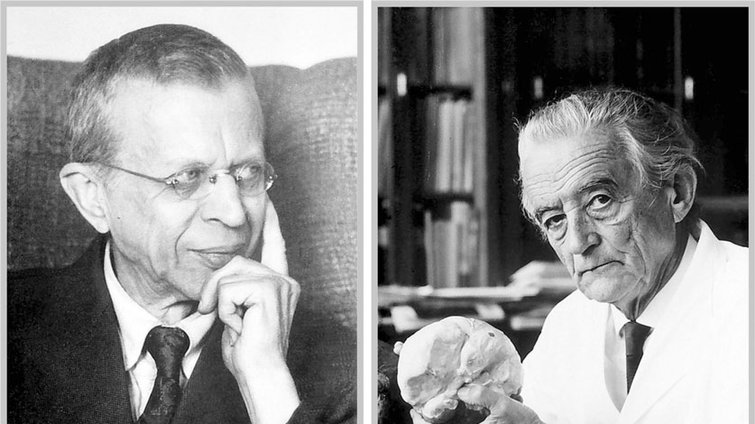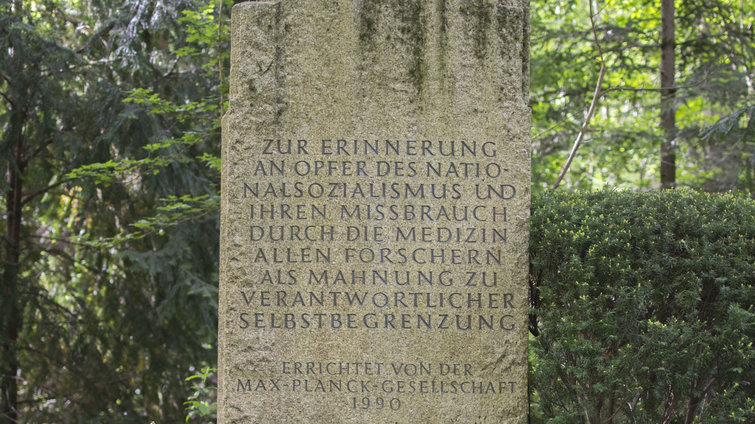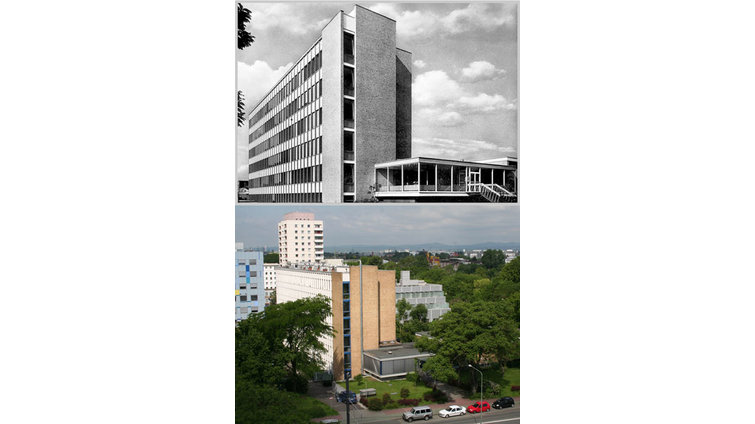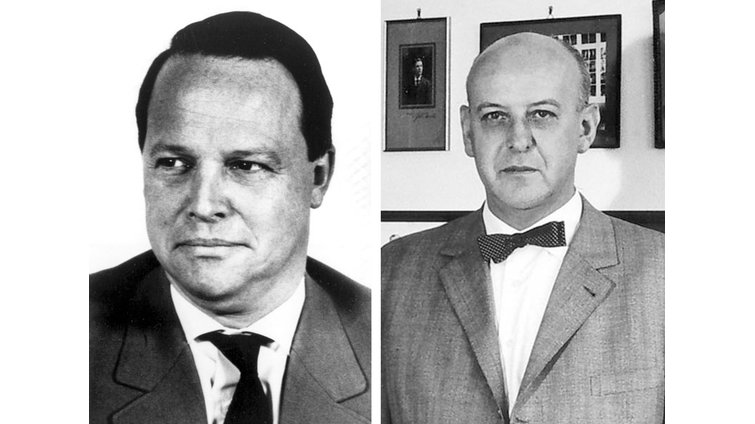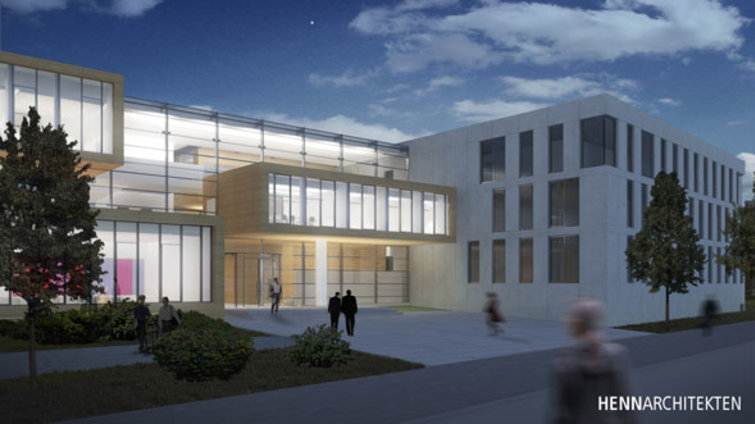History
Origins
The "Kaiser-Wilhelm-Institut für Hirnforschung" (KWI for Brain Research) was founded in Berlin in 1914, making it one of the oldest institutes of the "Kaiser Wilhelm Society for the Advancement of Science", itself founded in 1911. It was based on the Neurologische Zentralstation (Neurological Center), a private research institute established by Oskar Vogt in 1898 and run together with his wife Cécile Vogt, also an accomplished brain researcher [1-3] (Fig. 1).
From 1901 to 1910, Vogt's coworker at this institute was Korbinian Brodmann (Fig. 2), who in 1909 established the cytoarchitectonic classification of cortical areas (Fig. 3) still in use today (e.g., his area 17 is the primary visual cortex). Oskar Vogt's own scientific achievements also were in the field of cortical cytoarchitectonics and myeloarchitectonics.
Lenin´s Brain
In the 1920s Oskar Vogt became interested in the potential morphological correlates of mental abilities, and hence in the neuroanatomical study of 'elite brains'. When Lenin died of a brain hemorrhage in 1924, his brain was preserved in formaldehyde, where it remained for two years. In 1926, Vogt was recruited by the Soviet government to help establish Lenin's genius via histological investigation of his brain. He was given some space in Moscow to carry out this work and two years later, a spacious and representative brick building that had been confiscated from an American business (Fig. 4). In it, he helped establish and then headed the Moscow Brain Institute (Fig. 5). Between 1926 and 1930, Vogt travelled to Moscow several times to supervise the work on Lenin's brain (Fig. 6) by the Russian collaborators who had been trained at Vogt's KWI for Brain Research in Berlin.
In 1927, Vogt gave a preliminary report on his findings in Moscow, concluding from his histological observations that Lenin must have been an athlete in associative thinking ("Assoziationsathlet") - a conclusion deemed farfetched by some of his neurologist colleagues and adversaries. Lenin's brain was, for a time, on display in the Lenin Mausoleum and now rests at Moscow's Brain Institute [4].
KWI in Berlin-Buch
World War I delayed the plans for a new building to house the KWI for Brain Research. The KWI's first proper building in Berlin-Buch was only inaugurated in 1931 (Fig. 7) under the directorship of Oskar Vogt. It was the world's largest and most modern brain research institute of its time, including Departments of Neurophysiology (Tönnies and Kornmüller), Neurochemistry (Marthe Vogt and Veit), Genetics (Timoféeff-Ressovsky), a Research Clinic (Soeken, Zwirner), and the Neuroanatomical Departments of Oskar and his wife Cécile Vogt. [1-3] Based on critical remarks Vogt had made about national socialism, a protective attitude towards Jewish coworkers at the institute, and rumors that he was a communist (spirited by his Moscow contacts), Vogt was pressed to early retirement by 1937. [4] The Vogts moved to Neustadt in the Black Forest and established another private brain research institute, funded in part by the family of steel baron Krupp (who had already funded Vogt´s first private institute in Berlin) and by Vogt´s own funds (Fig. 8).
In 1937, Hugo Spatz [5], a pupil of Franz Nissl, became Vogt's successor as director of the KWI for Brain Research and head of the Neuroanatomy Department. During his tenure, the Departments of Neuropathology (Hallervorden [6]) and of Tumor Research (Tönnis) were added. One focus of both Spatz’s and Hallervorden’s histological research were pathologies of the extrapyramidal/motor system. In a previous collaboration they had described an extrapyramidal desease that was later named Hallervorden-Spatz syndrome.
A Dark Period
Between 1940 and 1945, Hallervorden and Spatz (Fig. 9) became involved in the atrocities of the Nazi regime by studying the brains of euthanasia victims.[7] For many years, brain sections from these studies remained archived in our institute (which by then had become the Max Planck Institute for Brain Research in Frankfurt am Main) together with research material from other periods. When this was recognized, all sections dating from the period 1933-1945 were given a burial at a Munich cemetery by the Max Planck Society in 1990. A memorial stone was erected in honor of the victims of these atrocities (Fig. 10).
More recently, (former) Directors of the Max Planck Institute for Brain Research realised that this history is not fully dealt with. See next chapter for the Recent Developments.
Recent Developments
In the 2014 anniversary book and exhibition “100 years of MPI: minds in motion” ( ISBN 9 783000 459771 ISBN 9 783000 458255), the Institute commemorated this tragic history. The current directors Moritz Helmstaedter, Gilles Laurent and Erin Schuman and directors emeritus Heinz Wässle and Wolf Singer state that:
"We believe it is essential to expose this grim history.
We commit to never allowing it to be forgotten."
In the beginning of 2015, Heinz Wässle discovered brain slices from this dark period in the Archives of the Max Planck Society and an investigation has been initiated. In addition, a commemoration event was organised on October 2015 for those children murdered at Brandenburg Görden on October 28, 1940. In addition, current directors (Erin Schuman, Gilles Laurent and Moritz Helmstaedter), directors emeritus (Wolf Singer and Heinz Wässle) and Max Planck research group leaders Tatjana Tchumatchenko and Johannes Letzkus, as well as Paul Weindling, were interviewed by Jasmine Wingfield, a London-based film director, writer and editor. The film about Julius Hallervorden and his involvement in the euthanasia program was shown on October 28, 2015 and can be viewed below.
To commemorate its past, the institute's directors initiated an annual Ethics in Science Lecture Series with lectures by Paul Weindling (2015), Jean-Pierre Changeux (2016) and Sarah Chan (2018).
In the beginning of 2017, the journal Science reported about the events taking place during the Third Reich period and mentioned that the Max Planck Society appointed a committee of experts to investigate the activities of former scientists of the Kaiser Wilhelm Society during the Nazi era and the exploitation of human material by scientists of its predecessor (Max Planck Society) even after WWII.
In June 2017, Heinz Wässle's investigations regarding the Hallervorden H-Serie were published in the historical journal Endeavour: Wässle, H. (2017). A collection of brain sections of „euthanasia“ victims: The Series H of Julius Hallervorden. Endeavour 41: 166-175. (June 21, 2017) Direct link to the paper
Further information on the victim research project can be found here:
https://www.mpg.de/victims-research-project
https://www.mpg.de/14472738/victim-research-project-interim-report
Dark Years: The Legacy of Euthanasia
Creation of the Max Planck Society
After 1945, the individual departments of the KWI for Brain Research were each relocated to Dillenburg, Giessen, Köln, Marburg or Göttingen. The year 1948 saw the creation of the Max Planck Society to succeed the Kaiser Wilhelm Society; the institute became the Max Planck Institute for Brain Research.
Hallervorden retired as director in 1955, and Spatz in 1959. In 1962, a new building was built in Frankfurt-Niederrad (Fig. 11) to house the Departments of Neurobiology (Hassler, Director 1959-1982) and Neuropathology (Krücke, Director 1956-1979) (Fig. 12), as well as the Research Groups "Evolution of the Primate Brain" (Stephan) and "Neurochemistry" (Werner).
Wilhelm Krücke, a pupil of Hallervorden, was a specialist of peripheral neuropathies. He was the reason for the institute's relocation to Frankfurt, because he was also the head of the 'Edinger Institute', the Neuropathology Department at the Frankfurt University Medical School. In 1982, what had in the past been the KWI for Brain Research's Department of General Neurology, relocated to Köln after WWII, became the Max Planck Institute for Neurological Research, an independent entity from Frankfurt’s MPI for Brain Research. The other relocated departments of the KWI were closed down with the retirement of their directors.
Rolf Hassler’s mixed legacy
Rolf Hassler was born in Berlin in 1914. He studied medicine and carried out his PhD at the Kaiser-Wilhelm Institute for Brain Research in Berlin-Buch under the supervision of Oskar Vogt (1936-1939) on Parkinson’s syndrome. After WWII, he moved to Freiburg where he became professor at the neurological/psychiatric university hospital in 1954. There, he cooperated with Traugott Riechert on stereotactic brain surgery. While Riechert operated, Hassler guided the electrocoagulation of thalamic loci as treatment for patients suffering of dystonias, chronic pain, compulsive disorders and Parkinson’s disease.
In 1959, Hassler became director of the neuroanatomy department, later called neurobiology department, of the MPI for Brain Research, and in 1962, moved from Freiburg to Frankfurt/Main, where the new MPI for Brain Research was now located. There, in addition to his neuroanatomical studies, Hassler continued to work on human stereotactic brain surgery. The surgeries were performed by Gert Dieckmann at the university hospital in Homburg/Saar. Hassler identified loci to be lesioned, and studied the patients both before and after surgery in Frankfurt. When Dieckmann became professor of psychosurgery in Göttingen, Hassler began a cooperation with Prof. Harm Spuler at the clinic for neurosurgery in Würzburg. Even after his retirement in 1982, when Wolf Singer and Heinz Wässle took over the institute, Hassler continued to participate in human stereotactic surgery while acting in the name of the institute. As psychosurgery was becoming increasingly controversial, in 1983 Wolf Singer and Heinz Wässle denied Hassler permission to use his affiliation to the institute. This led to the publication of an article in the BildZeitung magazine, criticizing Singer and Wässle for their lack of support for Hassler (link to the article). Hassler died soon after this (1984).
In recent years, Hassler’s human stereotactic lesions work has been the object of renewed interest. Prominent among them is Dr. Lara Rzesnitzek, who is both a psychiatrist and a medical historian at the Charité University Hospital in Berlin. In 2008, she wrote a thesis in Tübingen entitled “Psychosurgery and deep brain stimulation, a historical and conceptual overview”. In 2019, she wrote a “Habilitation thesis” entitled “The establishment of shock therapies and leucotomy in Germany”. This work, which complements several publications on stereotactic surgeries in German, focuses on Hassler’s contributions. Movies that Hassler made of the patients before and after surgery are kept in the archive of the Max Planck Society. These movies have been digitized and can be consulted for historical studies (mpg-archiv[at]archiv-berlin.mpg.de).
Sonja Toepfer, an artist and cinematographer, recently published on her homepage an interview with Prof. Volker Sturm, the former director of the clinic for stereotactic and functional neurosurgery of the university hospital in Cologne. Sturm was trained by Dieckmann and Hassler in Homburg/Saar and describes in this interview the types of patients who were treated there with stereotactic lesions.
Recent History
In 1981, the MPIH was restructured towards non-clinical, basic neuroscience through the establishment of the Departments of Neuroanatomy (Wässle, Director 1981-2008) and Neurophysiology (Singer, Director 1982-2011), followed by the Department of Neurochemistry (Betz, Director 1991-2009) (Fig. 13). Heinz Wässle conducted functional and structural studies of the mammalian retina, Heinrich Betz analyzed the molecular components of synapses, and Wolf Singer studied higher cognitive functions with a focus on the visual system. The emeritus pages of our website give details of their scientific achievements.
In the first decade of the new millennium, the MPG defined the analysis of neural networks as a central research topic for the institute. In 2008 Erin Schuman and Gilles Laurent were appointed as directors of the departments "Synaptic Plasticity" and "Neural Systems", respectively. Both departments took up work in the summer of 2009 and were initially located in interim facilities on the Science Campus "Riedberg" of the Frankfurt University. The construction of a new building for the institute on this campus was finalized in April 2013, next to the MPI of Biophysics. (Fig. 14). The new institute building currently houses the three departments of the institute (those of Erin Schuman, Gilles Laurent and Moritz Helmstaedter, latter since August 2014), Max Planck Research Groups at the institute (Tatjana Tchumatchenko, Johannes Letzkus (till 2020), Hiroshi Ito, Julijana Gjorgjieva and Vanessa Stempel), several core facilities, and the Max Planck Research Unit for Neurogenetics of Peter Mombaerts.
In 2016 a general audit of human specimens was conducted at the Max Planck Society and concluded with no further finds. The “Victims of Euthanasia” Committee set up by the President of the Max Planck Society under the leadership of Emeritus Professor Heinz Wässle (MPI for Brain Research) has succeeded in recruiting four international experts in the persons of Patricia Heberer-Rice (US Holocaust Memorial Museum), Gerrit Hohendorf (Technical University of Munich), Paul Weindling (Oxford Brookes University) and Herwig Czech (Medical University of Vienna), who have submitted a funding application for an independent victim research project. The project started in June 2017 and is funded by the Max Planck Society over a period of three years in the amount of 1.5 million euros. Further information and an interim report of the victim research project submitted to the Bavarian parliament can be found on the website of the Max Planck Society:
Victim research project interim report
Ernst Strüngmann Institute
The year 2008 also saw the foundation of the Ernst Strüngmann Institute for Neurosciences (ESI). The ESI is an independent research institute financed by the Ernst Strüngmann Foundation which was created by Drs. Andreas and Thomas Strüngmann and named after their father Dr. Ernst Strüngmann. The ESI is under the scientific governance of the Max Planck Society with the mission to perform excellent fundamental brain research. ESI’s founding directors are Prof. Wolf Singer and Prof. Pascal Fries. On 1 April 2011, when Prof. Singer assumed emeritus status at the Max Planck Institute for Brain Research, he joined the ESI as Senior Research Group leader.
Illustrations and References
Images are reproduced with kind permission from the following copyright holders:
C. & O. Vogt Archive, Institute of Brain Research, University Düsseldorf: Figs. 1, 2, 4
Archive of the MPI for Brain Research: Figs. 3 left, 9, 11 top, 12, 13
Archive of the Max Planck Society, Berlin-Dahlem: Figs. 7, 8
Henn Architekten: Fig. 14
Leo Peichl: Fig. 11 bottom
Arjan Vink: Fig. 10
Figs. 3 right, 5, 6 are from the public domain.
References and Links
[1] http://en.wikipedia.org/wiki/Oskar_Vogt (English) http://de.wikipedia.org/wiki/Oskar_Vogt (German)
[2] http://en.wikipedia.org/wiki/Cécile_Vogt-Mugnier (English) http://de.wikipedia.org/wiki/Cécile_Vogt (German)
[3] I. Klatzo (2002) Cécile and Oskar Vogt: The visionaries of modern neuroscience. Acta Neurochirurgica Suppl. 80. Springer-Verlag Wien - New York
[4] J. Richter (2007) Pantheon of brains: The Moscow brain research institute 1925-1936. J. Hist. Neurosci. 16:138-49.
[5] http://de.wikipedia.org/wiki/Hugo_Spatz (German)
[6] http://de.wikipedia.org/wiki/Julius_Hallervorden (German)
[7] H.-W. Schmuhl (2000) Hirnforschung und Krankenmord. Das Kaiser-Wilhelm-Institut für Hirnforschung 1937-1945. Aus: Forschungsprogramm "Geschichte der Kaiser-Wilhelm-Gesellschaft im Nationalsozialismus", herausgegeben von der Präsidentenkommission der Max-Planck-Gesellschaft.
http://www.mpiwg-berlin.mpg.de/KWG/Ergebnisse/Ergebnisse1.pdf
Other articles of this Research Program can be found at:
http://www.mpiwg-berlin.mpg.de/KWG/publications.htm#Ergebnisse

